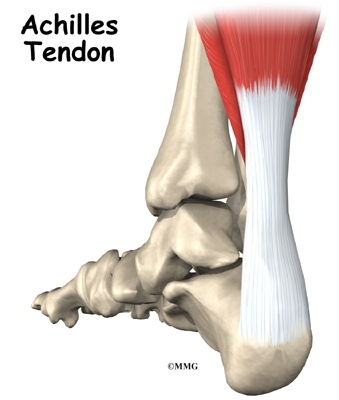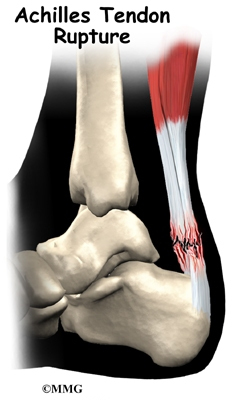 The low grade soreness in my right Achilles tendon has lasted long enough to get my attention. it isn’t painful, just sore. Warming up usually loosens it up and it isn’t preventing me from working out, though I have had to shorten my stride considerably on the treadmill. I don’t want it to get worse, so I did some homework.
The low grade soreness in my right Achilles tendon has lasted long enough to get my attention. it isn’t painful, just sore. Warming up usually loosens it up and it isn’t preventing me from working out, though I have had to shorten my stride considerably on the treadmill. I don’t want it to get worse, so I did some homework.As you can see from this drawing that I found on eOrthopod.com, the Achilles tendon is really big. It attaches the calf muscles to the very short lever at the back of the heel and allows the foot to flex. If you can stand on your toes, thank Achilles. This is one butch rope of tissue.
According to Dr. Stephen Pribut, DPM (that's a foot doc for the acronymically challenged), "Soreness” in a tendon is not something to ignore or "run through". Tendons don’t get sore like muscles do. Tendons hurt when they are injured. In other words, the discomfort I'm feeling isn't the
 result of normal exertion like when I lift heavy weights and my muscles feel especially "present" the next day. If a tendon hurts, that's not soreness, that's pain. A painful injured Achilles tendon is something to take seriously and requires immediate attention. Otherwise it will just get worse. The tendon can even rupture (tear) and break completely leaving a runner with months of expensive rehab and NO running while the surgically repaired tissue heals. A ruptured Achilles sucks most profoundly.
result of normal exertion like when I lift heavy weights and my muscles feel especially "present" the next day. If a tendon hurts, that's not soreness, that's pain. A painful injured Achilles tendon is something to take seriously and requires immediate attention. Otherwise it will just get worse. The tendon can even rupture (tear) and break completely leaving a runner with months of expensive rehab and NO running while the surgically repaired tissue heals. A ruptured Achilles sucks most profoundly.Like everything else involving health and the internet, there is plenty of controversy about what to do about Achilles pain, but these seem to be consensus opinions.
LEAVE THE MACHISMO IN YOUR LOCKER
Dr Pribut's first instruction is one everyone agrees with: rest. You don’t have to stop exercising, but slow down. Ease up on things that put particular strain on the tendon: Hill running, Sprinting, Deep stretches of the calf muscles. Shoes with too soft a heel can also cause the Achilles to stretch too far after the foot's initial impact when you're running or walking. Running on your toes instead of your heels will wack you up. I think mine may be the result of too long a stride. Shortening up and taking more smaller steps is helping me. This tendon is terrifically strong because it sustains tremendous force, even during something as simple as walking. Like the cable and pulley on a weight machine, the Achilles is always under strain whenever the foot is in motion. So rule one is - go easy .
FIRE AND ICE (AND A NICE RUB DOWN)
In an article in the Jewish World Review , Marlene Cimons (who lacks an acronym, but does her homework) reports that ice after exercise and heat before bed will help control inflamation and relax the gastrocnemius which is a very impressive word for calf muscle. A non-steroidal anti-inflammatory can help - cortisone is wicked bad. Don't let the doc shoot you with it to ease the pain. Cortisone will make you feel better for a while, but it also weakens the fibers in the tendon making it even more prone to tear or rupture.
Massaging the calf can also help. Heel lifts, tape, and elastic braces can get you through the day, but still, only rest will allow the injury to heal.
CoolRunning has some good stretches for prevention and maintenance for runners. When returning from an Achilles injury, wall pushups and hamstring stretches are especially important. I have had some really bad results from the towel around the foot thing. I think I actually aggravated the injury by pulling too hard. Your mileage may vary.
DON'T CROSS TRAIN AT CROSS PURPOSES
The amazingly named achillestendon.com, recommends some common sense things (stay fit, go easy, check for injury after your workout) and one really interesting one. When you do strength training and run on the same day - run first. Strength training is based on microscopic injury and healing of muscles. Running after weakening your muscles with resistance training just sets you up for further injury.
NO PAIN, NO PAIN
In a wise and funny essay called How Not to Treat and Achilles Injury by a writer named Wiltsey, this advice makes a lot of sense to me:
Achilles pain is really easy to fix unless you get stupid. Then it's really easy to make really really bad. Take it seriously and take it easy until it gets better.“Pain sucks”--This might seem obvious, but if it hurts, back off. Cut down your workout to minimal, preferably rest. Although this is anathema to most training athletes, better to miss a couple weeks than your entire season, like me.
My doctor gave me a simple rule to live by- “Let pain be your guide.” Simply, if it hurts, don’t do it and back off. A good recovery program is a must. Consult your coach, or begin with 5 minute sets of walking and every few days add thirty seconds of light jogging.
That's what I learned in school today..
WORKOUT UPDATE
My big meeting concluded on Thursday and I went straight to the gym. I had a lot of steam to blow off.
I did a light warm up on the treadmill, then spent a long time stretching. I’m not noticing any increase in flexibility yet - but I am definitely feeling a much shorter recovery time so I can tell that stretching after warmups and after the workout itself is making a difference.
I worked out with the resistance bands and really tried to hold my form while going as fast as I could, snapping each rep against the resistance of the band. It still feels ridiculous when I do it, but my doubts all disappear the next day when my body lets me know that the exercises have done their work. I’m going to do a session with machines and some free weights on Saturday to measure my progress and keep my chops up.
And I guess I better spend some more time on the elliptical for a while.
Peace,
Pennsy
Hi Pennsey:
ReplyDeleteCool page. I also had some Achilles tendon problems. The sites you point out were helpful, especially the achillestendon.com site.
Thanks,
Wendy
Pennsey and Wendy:
ReplyDeleteI agree - I find the information on AchillesTendon.com very helpful too. At first I found it helpful in treating my Achilles tendons, now I find it helpful in preventing a re-occurrence of Achilles tendon injury.
Ken